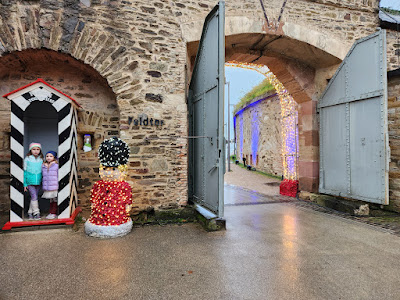After staying in hotels for a week plus it was nice to get into our Koblenz AirBnB that had our own kitchen and laundry.
Our condo for the next few days became our home base for site seeing in the region and also a bit of a re-tracing of a family trip from 1993 with my parents and two eldest brothers. But first off being a tourist in and around Koblenz.
The German Corner
Koblenz is named after the old latin word meaning confluence which is apt as the City lies at the confluence of the Mosel and Rhine river. The actual confluence is today known as the "German Corner", a symbol of the unification of Germany that features an equestrian statue of Emperor William I. The monument and statue is massive. The girls didn't quite know what to think of it - they laughed at the size of the horse's butt. Chrissy and myself both made the snide remark that we had seen bigger horses asses in our day.
After a few weeks of rain both rivers were quite high and it was fun to watch the water actually come together. It was cool to think of how these rivers had been so influential to the development of the area and the life of millions through the years. I cannot even fathom how many people before had stood there and watched these rivers combine and carry on. Bodies of water can sometime get me a bit sentimental.
Ehrenbreitstein Fortress
The Large Fortress of Koblenz, officially "Fortress Koblenz and Ehrenbreitstein", is a system of Prussian fortifications built between 1815 and 1834 to secure the then strategically important confluence of the Rhine and Moselle rivers.
After viewing the Fortress from the German Corner we took the car across the river to tour the property (the gondola was an option, but not one the kids were willing to take). It was actually the first day of the Christmas light up so the whole fortress was relatively empty as staff were setting up the lights and displays for the night time kickoff. In a way we got the best of both the usual fortress experience and the Christmas light up.
Stolzenfels Castle
Built originally to collect tolls on the Rhine the castle was destroyed during the War of the Palatinate Succession. After Napoleon's defeat, the castle became the property of the city of Koblenz and eventually it was donated to the Prussian Crown Prince Friedrich Wilhelm.
Today Stolzenfels Castle is known as a peak example of Prussian romanticism. It is truly beautiful and was a highlight for the girls to see a fairy-tale like castle.
 |
| The windy path leading up to the top of the river bank castle is its own highlight |
Other Highlights
- Basilica St. Castor
- This delicious and slightly hilarious charcuterie "board"
- The generic daily activity of walking to the grocery store to grab supper and beer and then watching familiar TV and movies in German with the kids.
Next Germany 2023 posts



























No comments:
Post a Comment